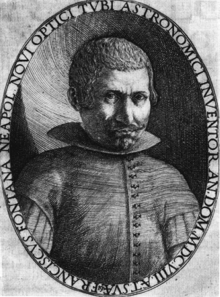Francesco Fontana

Francesco Fontana (1580–c. 1656) was an Italian lawyer (University of Naples[1] ) and an astronomer.
He created woodcuts showing the Moon and the planets as he saw them through a self-constructed telescope. In 1646 he published most of them in the book Novae coelestium terrestriumq[ue] rerum observationes, et fortasse hactenus non vulgatae. In 1645, he claimed to have observed a satellite of Venus (Paul Stroobant demonstrated in 1887 that all similar observations were not related to a putative satellite of Venus).
The lunar crater Fontana and the crater Fontana on Mars are named in his honor.
Note: See Donato Creti for paintings of planets from the next century.
Microscope
Fontana also claimed to have invented the compound microscope (two or more lenses in a tube) in 1618, an invention that has many claimants including Cornelis Drebbel, Zacharias Jansen or his father Hans Martens, and Galileo Galilei.[2]
References
- ↑ Hockey, Thomas (2009). The Biographical Encyclopedia of Astronomers. Springer Publishing. ISBN 978-0-387-31022-0. Retrieved August 22, 2012.
- ↑ |A Practical treatise on the use of the microscope by John Thomas Quekett
External links
![]()
- Novae coelestium ... observationes (1646, Latin)